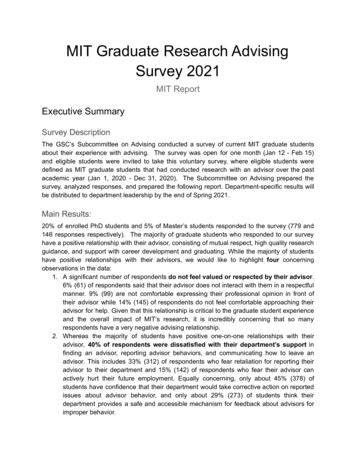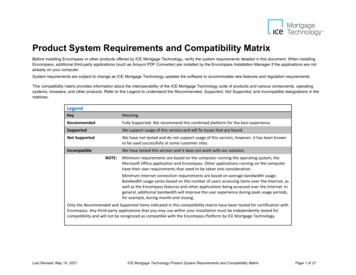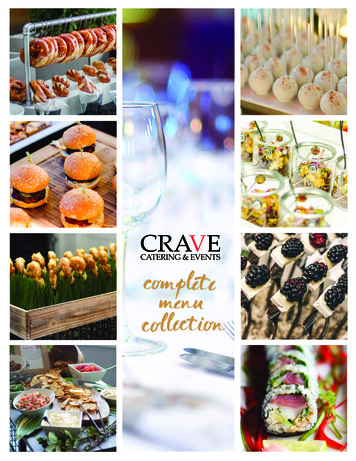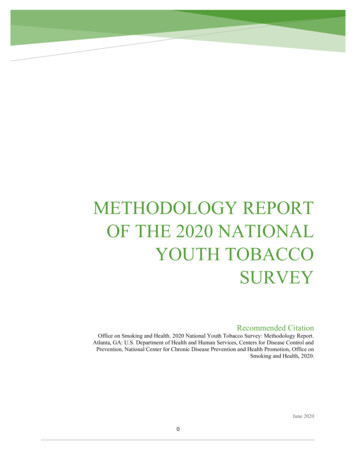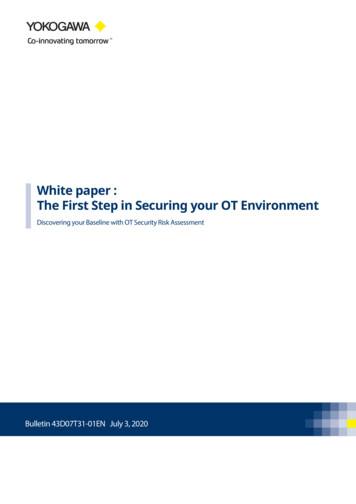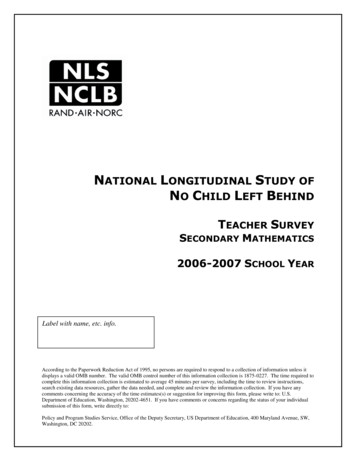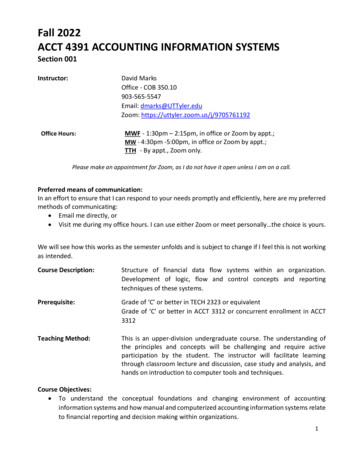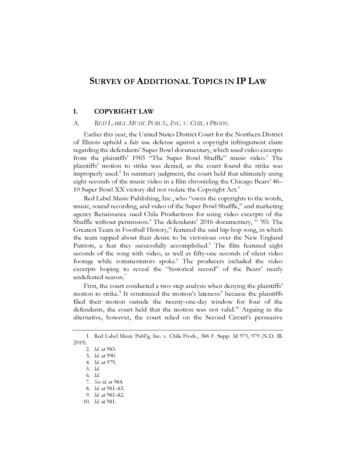
Transcription
SURVEY OF ADDITIONAL TOPICS IN IP LAWI.COPYRIGHT LAWA.RED LABEL MUSIC PUBL’G, INC. V. CHILA PRODS.Earlier this year, the United States District Court for the Northern Districtof Illinois upheld a fair use defense against a copyright infringement claimregarding the defendants’ Super Bowl documentary, which used video excerptsfrom the plaintiffs’ 1985 “The Super Bowl Shuffle” music video.1 Theplaintiffs’ motion to strike was denied, as the court found the strike wasimproperly used.2 In summary judgment, the court held that ultimately usingeight seconds of the music video in a film chronicling the Chicago Bears’ 46–10 Super Bowl XX victory did not violate the Copyright Act.3Red Label Music Publishing, Inc., who “owns the copyrights to the words,music, sound recording, and video of the Super Bowl Shuffle,” and marketingagency Renaissance sued Chila Productions for using video excerpts of theShuffle without permission.4 The defendants’ 2016 documentary, “ ’85: TheGreatest Team in Football History,” featured the said hip-hop song, in whichthe team rapped about their desire to be victorious over the New EnglandPatriots, a feat they successfully accomplished.5 The film featured eightseconds of the song with video, as well as fifty-one seconds of silent videofootage while commentators spoke.6 The producers included the videoexcerpts hoping to reveal the “historical record” of the Bears’ nearlyundefeated season.7First, the court conducted a two-step analysis when denying the plaintiffs’motion to strike.8 It scrutinized the motion’s lateness:9 because the plaintiffsfiled their motion outside the twenty-one-day window for four of thedefendants, the court held that the motion was not valid.10 Arguing in thealternative, however, the court relied on the Second Circuit’s persuasive1.2019).2.3.4.5.6.7.8.9.10.Red Label Music Publ’g, Inc. v. Chila Prods., 388 F. Supp. 3d 975, 979 (N.D. Ill.Id. at 983.Id. at 990.Id. at 979.Id.Id.See id. at 984.Id. at 981–83.Id. at 981–82.Id. at 981.
1338BERKELEY TECHNOLOGY LAW JOURNAL[Vol. 34:1337approach in applying Twombly and Iqbal to affirmative defenses to deny themotion regardless, by applying the plausibility standard.11 It held that thedefendants “alleged facts that enable the court to draw the reasonableinference that they are not liable for the misconduct alleged.”12Next, the court analyzed the defendants’ fair use defense. It held that thenew purpose of the film and brief length of the video excerpts weighed infavor of fair use.13 The music video was “originally intended to entertain andraise money” while the documentary intended to “comment on the sportsocial phenomenon that was the 1985 Chicago Bears.”14 As a result, plaintiffand defendant had different purposes in using the video.15 For the defendantsin particular, the Shuffle snippets were used “not for [their] expressive content,but rather for [their] factual content.”16 In other words, the video was used tochronicle history.17 The court held that this kind of historical commentary“adds something new . . . .”18 Although the documentary was made forcommercial gain, the court still reasoned that this was only incidental, since itdid not compete in the same market as the music video.19 Thus, the first factorof fair use weighed in favor of the defense.20The second factor, the nature of the copyrighted work, was neutral,because the music video and documentary complemented one another.21 Thethird factor, considering the amount taken “in relation to the copyrighted workas a whole,” revealed that 17% of the music video only made up 1% of thefilm.22 This too weighed in favor of fair use, especially since it reinforced theearlier finding that the film was not seeking to duplicate the Shuffle.23 Finally,the fourth factor, the market effect, was also largely neutral, as it wasinconceivable that the video excerpts in the documentary would dissuade aviewer from purchasing the song.24The court ultimately concluded that the first and third factors weighed infavor of fair use, granting the defendants’ motion for summary judgment.25 It11.12.13.14.15.16.17.18.19.20.21.22.23.24.25.Id. at 982–83.Id. at 983.Id. at 983–85, 986.Id. at 984.Id.Id.See id. at 985.Id. at 984.Id. at 985.Id.Id.Id. at 986.See id. at 984, 986.See id. at 989.Id. at 989–90.
2019]SURVEY OF ADDITIONAL TOPICS IN IP LAW1339cited the Fourth Circuit, which stated that fair use “protects filmmakers anddocumentarians from the inevitable chilling effects of allowing an artist toomuch control over the dissemination of his or her work for historicalpurposes.”26 The court held that this was what the Copyright Act had intendedwhen providing a shield against infringement.27B.HIQ LABS, INC. V. LINKEDIN CORP.The United States Court of Appeals for the Ninth Circuit recently uphelda preliminary injunction which, in effect, allows hiQ Labs to copy informationfrom public profiles on LinkedIn using a computer program28—a practiceknown as “scraping.”29 HiQ Labs is a data analytics company that usesinformation scraped from public LinkedIn profiles to power two of itsproducts: “Skill Mapper” and “Keeper.”30 “Skill Mapper” summarizes the skillsof a client’s employees, enabling the client to identify “skill gaps” “so that theycan offer internal training in those areas.”31 “Keeper” utilizes scraped data toidentify the employees within a client’s company who are most likely to “[be]recruited away.”32 About one month before LinkedIn launched “a dataanalytics tool similar to [hiQ’s] products,” the company sent hiQ Labs a ceaseand-desist letter and placed barriers on its site to prevent hiQ Labs fromscraping.33 Shortly thereafter, hiQ Labs brought an action against LinkedInseeking to enjoin them from restricting access to the information on publicprofiles.34 The United States District Court for the Northern District ofCalifornia granted a preliminary injunction against such.35The Ninth Circuit, in determining whether to uphold the preliminaryinjunction, applied a four-pronged test: the plaintiff must show (1) that theywill likely suffer irreparable harm if preliminary relief is not granted, (2) “thatthe balance of equities tips in [their] favor,” (3) that they are “likely to succeedon the merits,” and (4) “that an injunction is in the public interest.”36 Inadministering the test, the court used a “sliding scale approach” where a26.2013)).27.28.29.30.31.32.33.34.2017).35.36.Id. at 989 (quoting Bouchat v. Balt. Ravens Ltd. P’ship, 737 F.3d 932, 944 (4th Cir.See id.HiQ Labs, Inc. v. LinkedIn Corp., 938 F.3d 985, 991, 1005 (9th Cir. 2019).Id. at 1004.Id. at 991.Id.Id.See id. at 991–92, 998.Id. at 992; see hiQ Labs, Inc. v. LinkedIn Corp., 273 F. Supp. 3d 1099 (N.D. Cal.HiQ Labs, Inc., 938 F.3d at 992.Id.
1340BERKELEY TECHNOLOGY LAW JOURNAL[Vol. 34:1337“stronger showing of one element could offset a weaker showing ofanother.”37In analyzing the first prong, the court examined whether hiQ Labs wouldsuffer irreparable harm if the preliminary injunction was not granted.38 HiQLabs’ business model relies entirely on access to LinkedIn’s information, asthere is no viable alternative source.39 LinkedIn argued that Facebook could bean acceptable alternative, but Facebook’s information is not readily accessibleand therefore not equivalent.40 The court found that hiQ Labs’ lack of accessto information had already caused them to lose financing and ultimatelythreatened the company with total extinction absent a preliminary injunction.41In light of this, the court concluded that the first prong was met.42Under the second prong, the court held that “the balance of the equities”tipped in favor of hiQ Labs.43 LinkedIn contended that user privacy should beprioritized over hiQ Labs’ ability to conduct business, arguing that a publicprofile did not authorize every use of user information.44 However, the courtreasoned that users with public profiles do not have an expectation of privacythat scraping would violate.45 Furthermore, LinkedIn undermined its argumentby launching its own version of hiQ’s products.46 By contrast, the court foundsignificant interest in hiQ Labs staying in business and completing itscontracts.47 Thus, the court reasoned that the “balance of the equities” tippedin favor of hiQ Labs.48In its evaluation of the third prong, the “likelihood-of-success prong,” thecourt focused its inquiry on whether hiQ Labs had “raised serious questionson the merits.”49 As a preliminary matter, the court held that hiQ Labs couldlikely establish all the elements required to show tortious interference with acontract.50 In an attempt to raise an affirmative defense, LinkedIn cited theComputer Fraud and Abuse Act (CFAA), asserting that hiQ’s scraping violated37. Id. (internal quotations omitted) (quoting Alliance for the Wild Rockies v. Cottrell,632 F.3d 1127, 1131 (9th Cir. 2011)).38. Id. at 993.39. Id.40. Id.41. Id. at 993–94.42. Id. at 994–95 (quoting CTIA-The Wireless Ass’n v. City of Berkeley, 928 F.3d 832,852 (9th Cir. 2019)).43. Id. at 994.44. Id.45. See id.46. Id. at 994–95.47. Id. at 995.48. Id. at 994–95.49. Id. at 995.50. Id. at 999.
2019]SURVEY OF ADDITIONAL TOPICS IN IP LAW1341the provision51 that prohibited “intentionally access[ing] a computer withoutauthorization or exceed[ing] authorized access, and thereby obtain[ing] . . .information from any protected computer.”52 However, the court rejectedLinkedIn’s defense on two grounds.53First, the court concluded that, for the purposes of the CFAA,“[a]uthorization is an affirmative notion” where access is granted to selectedparties.54 LinkedIn could not claim that access to its public profiles requiredauthorization, since the profiles are accessible by anyone with a computer.55Therefore, hiQ Labs’ scraping did not “exceed authorization”56 because noauthorization was required to begin with.57Secondly, the court concluded that the legislative intent behind the CFAAwas to prohibit the computer equivalent of “breaking and entering.”58 As hiQLabs merely gleaned information which was open and available to the publicand did not breach any protective barriers, such as passwords, to access theinformation, the court reasoned that their scraping was not analogous to“breaking and entering.”59 Thus, the CFAA did not apply as an affirmativedefense and accordingly, the court determined that hiQ Labs had raised seriousquestions on the merits.60Finally, the court found that public interest factors tipped in favor of hiQLabs.61 Though LinkedIn argued that its ability to prevent “malicious” attackson its servers constituted a substantial public interest, hiQ Labs countered thatthe greater public interest was in allowing the collection of information.62 Thecourt sided with hiQ Labs, reasoning that LinkedIn’s barriers were notpreventing a malicious attack, but denying access to information that thecompany did not even own.63 Furthermore, striking the preliminary injunctiondown would be antithetical to public interests because LinkedIn would gain amonopoly over publicly available information.64 Conversely, the court agreedwith hiQ Labs that data scraping serves a significant public interest since d. (quoting 18 U.S.C. § 1030(a)(2)(C) (2019)).HiQ Labs, Inc., 938 F.3d at 1000.Id.See id. at 1001–02.18 U.S.C. § 1030(a)(2)(C).HiQ Labs, Inc., 938 F.3d at 1003–04.Id. (quoting H.R. REP. NO. 98-894, at 20 (1984)).Id. at 1001, 1003–04.Id. at 1004.See id. at 1005.Id. at 1004–05.Id. at 1005.See id.
1342BERKELEY TECHNOLOGY LAW JOURNAL[Vol. 34:1337researchers use it to gather information.65 In all, the court reasoned that thepublic interest factors favored hiQ Labs.66The Ninth Circuit thus concluded that all four prongs of the preliminaryinjunction test were met, upheld the District Court’s preliminary injunctionenjoining LinkedIn from prohibiting hiQ Labs’ scraping, and remanded forfurther proceedings.67II.TRADEMARK LAWA.PATAGONIA, INC. V. ANHEUSER-BUSCH, LLCThe United States District Court for the Central District of Californiadenied a motion to dismiss brought by Anheuser-Busch, LLC regardingseveral of Patagonia, Inc.’s claims for violations of state and federal trademarklaw.68 Patagonia’s claims arose from Anheuser-Busch’s use and procurementof the trademark PATAGONIA in the beer industry.69Patagonia regards its PATAGONIA trademark and P-6 logo as among“the most identifiable brands in the world.”70 The company has also built abrand around environmental consciousness, in part through an environmentalnon-profit established by Patagonia’s CEO.71 Patagonia and its relatedcompanies have predominately used the trademark and logo in the context ofapparel.72 However, Patagonia has used its PATAGONIA PROVISIONSmark to identify and promote food items, including beer.73The story of how Anheuser-Busch came to regard itself as the owner ofthe PATAGONIA trademark as it pertains to beer is hazy.74 An AnheuserBusch attorney filed a Statement of Use on behalf of their competitor—another beer importer—to avoid termination of the trademark, which thecompetitor held at the time.75 The competitor had exhausted its ability torequest extensions to show the use of the trademark from the United StatesPatent and Trademark Office (USPTO).76 Prior to the termination of the final65. See id. at 1004.66. Id. at 1005.67. See id.68. Patagonia, Inc. v. Anheuser-Busch, LLC, No. 2:19-cv-02702-VAP-JEMx, at *20(C.D. Cal. Sept. 3, 2019).69. Id. at 3.70. Id. at 2. The P-6 logo depicts six mountains with “Patagonia” written at the base ofthose mountains. Id. at 4.71. Id. at 2.72. See id.73. Id.74. See id. at 2–3.75. Id. at 4.76. Id.
2019]SURVEY OF ADDITIONAL TOPICS IN IP LAW1343extension window, the Anheuser-Busch attorney pointed to a single bottle ofPATAGONIA beer in the aforementioned Statement of Use filed on behalfof the competitor.77 The USPTO, regarding this showing as proof of the useof the trademark in interstate commerce within the requisite time window,issued the trademark to the competitor, who then assigned it to AnheuserBusch.78Years later, Anheuser-Busch brewed up and acted on a plan to launch aPATAGONIA beer.79 The promotional launch of the beer took place at a skiresort.80 The beers were sold out of a stand bearing a logo with severalmountain peaks and the text “Patagonia Cerveza” at the base of thosemountains.81 The beer bottles had the same logo.82 The Anheuser-Busch staffselling the beer wore jackets with the same logo as well.83 Finally, thepromotion also included a pledge from Anheuser-Busch to “plant one tree forevery case of beer purchased.”84Patagonia brought several trademark-related claims against AnheuserBusch in response to Anheuser-Busch’s use and procurement of thetrademark.85 Anheuser-Busch filed a Federal Rules of Civil Procedure Rule12(b)(6) motion to dismiss the federal trademark dilution claims, Californiatrademark statutory law claims, and the federal Lanham Act claims.86The court reviewed the trademark dilution claim by assessing whetherPatagonia sufficiently pleaded that the PATAGONIA trademark was “famousand distinctive.”87 The court considered four non-exclusive factors in itsreview: the duration of the publicity of the mark, the volume of salesconducted under the mark, the public’s recognition of the mark, and theregistration status of the mark.88 Patagonia argued that their decades-long useof the trademark, bolstered by the company’s “enormous” investments inadvertisement and promotion, qualified PATAGONIA as famous since wellbefore its use by Anheuser-Busch.89 In holding the allegations as true andconstruing the facts in favor of Patagonia, the court held that Patagonia had77.78.79.80.81.82.83.84.85.86.87.88.89.Id. at 18.Id. at 5.Id. at 3.Id.Id.Id.Id. at 4.Id. at 3.Id. at 5.Id. at 8, 10–11.Id. at 8.Id. at 9.Id.
1344BERKELEY TECHNOLOGY LAW JOURNAL[Vol. 34:1337adequately made out its claim by alleging a trademark registration date of 1982, 10 billion in sales since 1985, and a global market for Patagonia products.90For the California trademark law claims, the court analyzed whetherPatagonia’s allegations sufficiently put Anheuser-Busch on notice of specificstate law claims.91 According to Anheuser-Busch, Patagonia cited “inapplicablestatutes” and, furthermore, failed to provide facts supporting claims underpotentially relevant statutes.92 Patagonia asserted that the substance of theircomplaint sufficed for notice and that discovery could resolve any issues inidentifying the proper statutes.93 The court sided with Patagonia’s view anddenied the motion.94Finally, the court addressed the motion to dismiss three of Patagonia’sLanham Act claims.95 The claims pertained to (1) the “anti-trafficking” rule,(2) the bar against the use of a trademark in a manner that falsely suggests aconnection with another entity, and (3) the ban of use of fraudulently procuredtrademarks.96The anti-trafficking rule within the Lanham Act prohibits assigning anintent-to-use application before the applicant files a verified statement thatthey are using the mark.97 Patagonia pleaded that Anheuser-Busch actually wasassigned the intent-to-use application prior to its competitor filing a Statementof Use.98 The court found Patagonia’s anti-trafficking and abandonment claimssufficient to overcome Anheuser-Busch’s motion to dismiss.99Anheuser-Busch contested Patagonia’s arguments for two reasons.100 First,they argued that “[Patagonia] cannot offer allegations that are ‘merelyconsistent with’ their favored explanation . . . .”101 But the court held that theallegations did more than support Patagonia’s favored explanation becausethey tended “to exclude the possibility that Anheuser-Busch’s explanation . . .is true.”102 Second, Anheuser-Busch denied that Patagonia had adequatelyalleged abandonment of the trademark.103 Here, the court agreed with90. Id. at 9–10.91. Id. at 10.92. Id.93. Id.94. Id.95. Id. at 11. The Lanham Act permits federal courts to cancel an invalid trademarkregistration. Id.96. Id. at 14–17.97. Id. at 11.98. Id. at 12–13.99. Id. at 15.100. Id. at 13–14.101. Id. at 13.102. Id. at 13–14.103. Id. at 14.
2019]SURVEY OF ADDITIONAL TOPICS IN IP LAW1345Patagonia that the several years between Anheuser-Busch’s registration of thetrademark and its use of the trademark evidenced discontinuance.104The court likewise denied Anheuser-Busch’s motion to dismiss the falsesuggestion claim.105 Anheuser-Busch contested two of the four elements ofPatagonia’s claim: the second element—that the mark was a nearapproximation of that used by Patagonia, and the fourth element—thatPatagonia had attained enough fame to infer that someone viewing AnheuserBusch’s PATAGONIA trademark would presume a connection withPatagonia.106 Regarding the second element, the court determined that a12(b)(6) motion did not facilitate the “fact-intensive inquiry” required forevaluating the approximation; therefore, the court held Patagonia’s allegationthat PATAGONIA “uniquely and unmistakably identified Patagonia” as trueand denied the motion.107 Regarding the fourth element, Anheuser-Buschargued that Patagonia failed to allege sufficient facts to show that consumers,at the time of the registration of the mark, would assume the mark belongedto Patagonia.108 But Patagonia’s showing of how U.S. consumers regarded thetrademark sufficed to convince the court otherwise.109The court denied Anheuser-Busch’s motion to dismiss the falseprocurement claim because Patagonia pleaded with sufficient particularity.110For example, the court cited as specific enough Patagonia’s evidence thatAnheuser-Busch falsely asserted the trademark was being used in a commercialcontext.111 The specificity standard for that evidence was met because a singlebottle of beer in a white-walled room could be alleged to not indicatecommercial use.112 Hence, based on the photo and similar specific evidence,the court did not find fault with the particularity of Patagonia’s fraudallegations.113In a war between Big Beer and Big Vest, it appears the first battle went toBig Vest.104. Id. The court also agreed that Anheuser-Busch failed to show any commercialintention to use the trademark during that window, as indicated by a lack of press releases andpromotional statements relating to Anheuser-Busch’s intent to use the trademark. Id.105. Id. at 17.106. Id. at 15.107. Id. at 15–16.108. Id. at 16.109. Id. at 16–17.110. Id. at 19.111. Id.112. Id.113. Id.
1346B.BERKELEY TECHNOLOGY LAW JOURNAL[Vol. 34:1337BANKSY’S FAKE STOREOn October 1, 2019, famed international street artist Banksy announcedhe was opening a shop in London named Gross Domestic Product.114 Banksyclaimed he had to open shop and sell his artwork in order to protect his namein a legal dispute against a greeting card company named Full Colour Black.115He alleged that Full Colour Black was contesting the trademark to his art, whilealso attempting to take custody of his name so the company could “sell theirfake Banksy merchandise legally.”116 The three-person company photographedBanksy’s public graffiti art to place on greeting cards.117 Full Colour Blackclaimed its purpose was to make Banksy’s official canvases available to “thepublic,” who cannot afford his art because “Banksy never makes anythingavailable to his fans.”118The trademark dispute began in March 2019 when Full Colour Blackcommenced invalidity proceedings to cancel an E.U. trademark on one ofBanksy’s famous murals, Rage, The Flower Thrower.119 Pest Control OfficeLimited, the entity which authenticates his art, registered the trademark for thispiece in August 2014.120 In the European Union, if an entity does not use its114. instagram.com/p/B3FAJKonJ z/ [https://perma.cc/83DA-PY2U].115. Lisette Voytko, Banksy Puts His Art Up For Sale In London, Starting at 12, FORBES(Oct. 1, 2019), ing-at-12/#79f1b3213d51 [https://perma.cc/DY3T-GZEN];see Tim Lince, “A frankly pointless step” – Why Banksy pop-up shop could hinder trademark case,WORLD TRADEMARK REV. (Oct. 2, 2019), ].116. Lanre Bakare, Banksy launches homewares shop in dispute over trademark, GUARDIAN (Oct.1, 2019), rademark [https://perma.cc/RR7A-PDES]; see Lince, supranote 2.117. See Full Colour Black, @FullColourBlack, FACEBOOK (Oct. 4, lack/public-statementrelease/2557627524344258/ [https://perma.cc/Z8B5-WQYT].118. Id.119. Enrico Bonadio, How Banksy’s latest trademark row could backfire, CONVERSATION (Oct.10, 2019), demark-row-could-backfire124919 [https://perma.cc/BR9A-ZZ5W]. The European Intellectual Property Office doesnot have a name on file for the art piece. The name is often interchangeable between Rage, theFlower Thrower, Flower Thrower, and Love Is In The Air. See (Trade mark without text) 012575155,EUROPEAN UNION INTELL. PROP. OFF., s/012575155 [https://perma.cc/ET63-2ZHN] (last visited Dec. 13, 2019); see alsoBanksy Artworks, ART STORY, /[https://perma.cc/5BN5-DH8J] (last visited Dec. 13, 2019) (referring to the piece as “Rage,the Flower Thrower”).120. Bonadio, supra note 6.
2019]SURVEY OF ADDITIONAL TOPICS IN IP LAW1347trademark in commerce, the trademark may be transferred to someone whowill use it for commercial purposes.121 Banksy has not used Rage, the FlowerThrower, in any commercial endeavors and therefore has a questionabletrademark title to this piece.122 To prevent the trademark transfer, Banksy’slegal team advised him to open up Gross Domestic Product to fulfill thetrademark requirements under E.U. law.123 The shop’s doors never opened, asBanksy conducted the sales through an online server with prices starting at 12.124Full Colour Black’s attorney, Aaron Wood, argued that opening up shopis “frankly pointless” because the company was not attempting to revoke thetrademark, but rather to challenge its legitimacy.125 Wood further alleged thatthe shop strengthened the trademark challenge because Full Colour Black isnot arguing that the trademark fails for lack of use in commerce.126 Instead,the greeting card business was challenging the legitimacy of Banksy’strademark entirely, claiming that Banksy is using trademark law to skirt therequirements of copyright law and to “monopolise his work in bad faith.”127Because artwork is generally protected through copyright law, the companyalleges that Banksy’s trademark registrations were done in bad faith to avoidexposing himself through copyright law.128Banksy pushes the protection of his name through trademark law ratherthan copyright law, claiming that “copyright is for losers.”129 Note that Banksyis famous in part for his ability to reach a global audience while keeping hisidentity hidden.130 If Banksy were to begin a copyright suit, this would requirePest Control to reveal his true identity in order to prove his ownership overhis art.131 Moreover, Full Colour Black has allegedly written Banksy and hislegal team on multiple occasions since 2010 to suggest paying him royalties,121. See Lince, supra note 2.122. Id.; see (Trade mark without text), supra note 7 (demonstrating adversarial proceedingsagainst the piece).123. Ellie Harrison, Banksy attacked for ‘tricking fans’ in ferocious statement by company at centre oftrademark row, INDEPENDENT (Oct. 5, 2019), emark-merchandiselondon-store-a9144231.html [https://perma.cc/FD92-QBD6].124. Voytko, supra note 2.125. Lince, supra note 2.126. See id.127. Id.128. Sharon Kirby, Copyright is for losers, trade marks are for Banksy – the Banksy trade mark caseexplained, LEXOLOGY (Oct. 23, 2019), https://www.lexology.com/library/detail.aspx?g 3ce410d3-e5a2-4cd2-917d-b1ff02e755be [https://perma.cc/B8AF-2B5Y].129. See Bonadio, supra note 6.130. Id.131. Id.
1348BERKELEY TECHNOLOGY LAW JOURNAL[Vol. 34:1337which Banksy declined.132 By refusing to accept these royalties, Full ColourBlack alleges that Banksy has refused his copyright and trademark rights tothese art pieces.133As the legal battle ensues, several questions remain unanswered,specifically, whether Banksy’s artwork, or anyone’s art piece, can provide atrademark right.134 Furthermore, it is uncertain if Banksy’s quick actions willbe seen as a genuine use of the trademark and whether it matters that the artistbegan using the art as commerce after the trademark was registered.135 IfBanksy knew that the work did not act as a trademark, but deliberately soughttrademark protection to circumvent copyright law, the E.U. IntellectualProperty Office may find the registration invalid.136132.133.134.135.136.Full Colour Black, supra note 4.See Bonadio, supra note 6.Lince, supra note 2.Id.See id.
2019] SURVEY OF ADDITIONAL TOPICS IN IP LAW 1341 the provision51 that prohibited "intentionally access[ing] a computer without authorization or exceed[ing] authorized access, and thereby obtain[ing] . . . information from any protected computer."52 However, the court rejected LinkedIn's defense on two grounds.53 First, the court concluded that, for the purposes of the CFAA,
